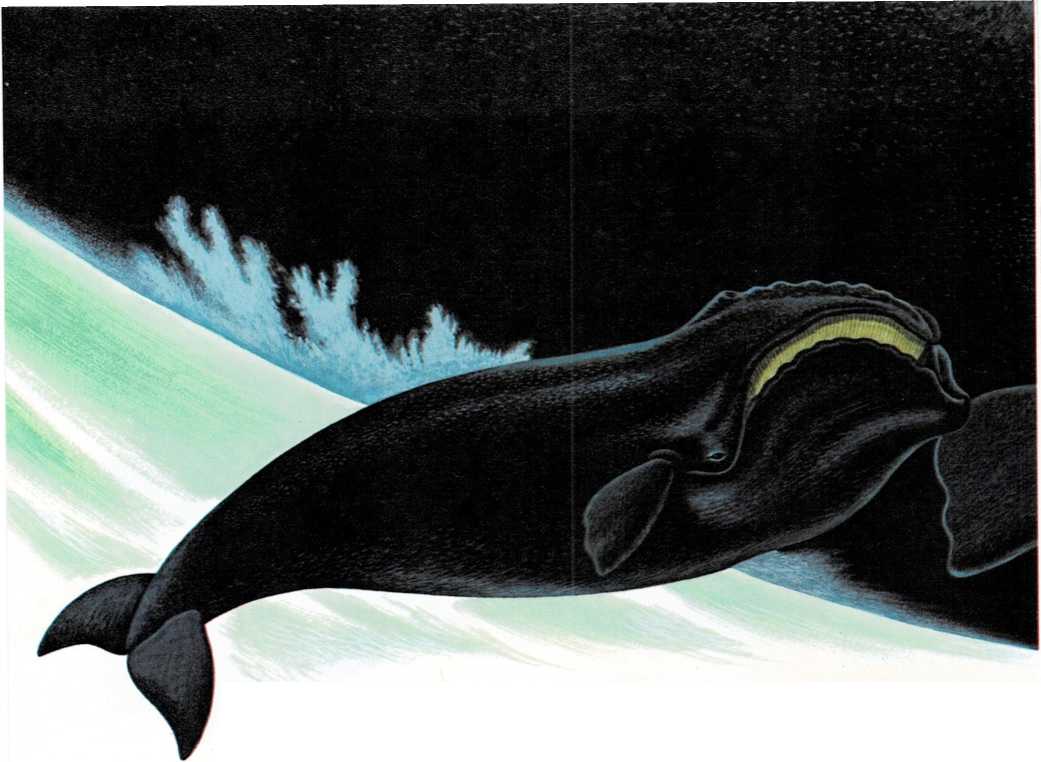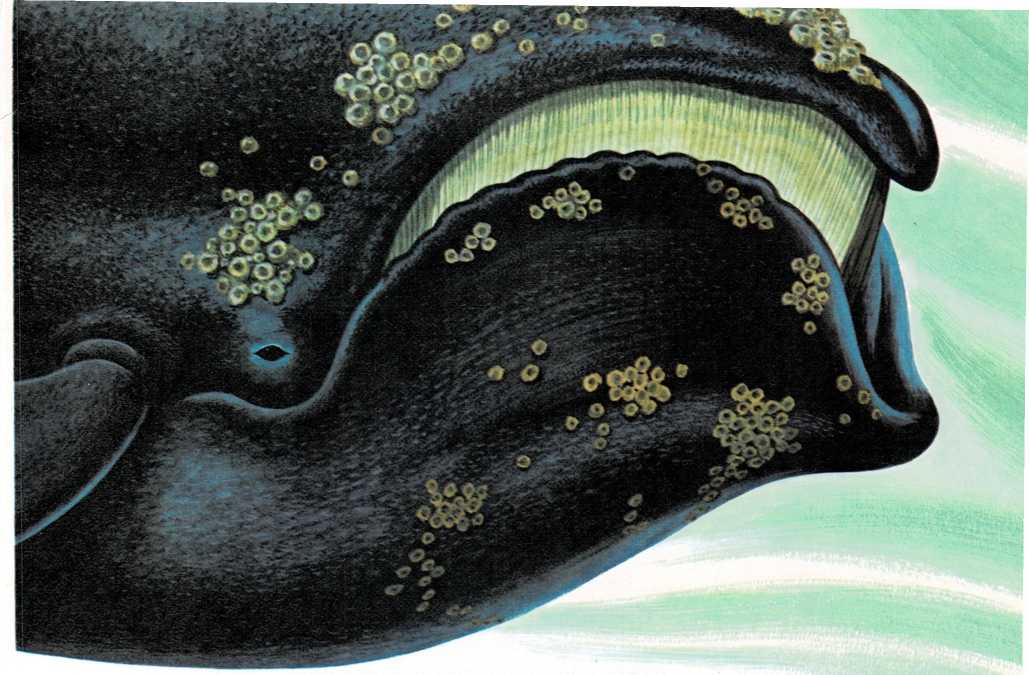
Whale families
Whales belong to a group of mammals called cetaceans (suh
[tay]{.smallcaps} shuhnz). The name means \”large sea animal.” There are
about seventy-five kinds of whales. They are divided into two groups.
Those called baleen (buh [leen)]{.smallcaps} whales, have no teeth.
Those called toothed whales, have teeth.
Baleen whales have hundreds of thin, bony triangles, called baleen, or
whalebone, hanging from the upper jaw. Baleen is made of the same
material as your fingernails.
These whales use the baleen to strain food out of the water. A baleen
whale takes in a big mouthful of water. It then squeezes the water out
through the baleen. Any food in the water is trapped in the baleen.

mother and baby right whales
Some kinds of toothed whales have teeth in both jaws, some only in the
lower jaw. They use their teeth to catch squid or fish, but not for
chewing. All toothed whales swallow their prey whole.
There are ten kinds of baleen whales. The biggest of all is the blue
whale, so-called because of its grayish-blue color. It is the biggest
creature that has ever lived. A blue whale may be a hundred feet (30 m)
long and weigh as much as twenty-five elephants! These giants live in
all parts of the sea.
Blue whales eat tiny shrimplike animals called krill that are part of
the plankton. It takes about two tons of krill to fill a blue whale’s
stomach! Krill swim in huge swarms near the surface of the water. The
whale swims through the krill, sucking water into its mouth. It then
squirts the water out and swallows the krill trapped in its baleen.
The second largest whale, the fin whale, is also a baleen whale. A fin
whale may be as much as eighty feet (24 m) long. Its body is
grayish-black, with a white underside and a white patch on the upper
jaw. These slender, graceful whales are fast swimmers.
Another baleen whale is the black right whale, usually called simply a
right whale. Its skin is black. About sixty feet (18 m) long, it is
fatter than the blue or fin whale. It has a huge head and a sort of bony
lump called a \”bonnet” on its nose.
The bowhead whale looks much like a right whale, but has no \”bonnet.”
It also has a patch of white on the end of its lower jaw. This whale has
the longest baleen of any of the baleen whales. Its baleen may grow to a
length of thirteen feet (4 m).
Bowheads are about sixty feet (18 m) long. They do not migrate, or move
about, as the other baleen whales do. They spend most of their time in
the Arctic Ocean.
The humpback whale is also a baleen whale. In spite of its name, it does
not have a hump on its back. It grows to a length of fifty feet (15 m).
One of the most active and playful of all whales, humpbacks often leap
clear out of the water, almost turning somersaults. They also often
\”stand” on their heads in the water, waving their tails rapidly back
and forth and sending clouds of spray into the air.
The smallest baleen whales are the minke and the pygmy right whale. The
minke, about thirty feet (9 m) long, lives in all the seas.

The pygmy right, no more than twenty feet (6 m) long, stays south of the
equator.
The biggest of the toothed whales is the dark-gray, square-headed sperm
whale. It is ■ about sixty feet (18 m) long. These whales live mainly in
the warmer seas. They often dive to great depths to find their favorite
food, squid and cuttlefish.
Big sperm whales will apparently attack giant squid. Many of these
whales have been seen with scars made by the powerful arms of the squid.
A sperm whale forty-seven feet (14 m) long was once found with a squid
thirty-four feet (10 m) long in its stomach!
There is a family of toothed whales called beaked whales. They were
given this name because they have long, rounded, beaklike snouts.
The biggest beaked whale is the giant bottle-nosed whale. It is about
forty feet (12 m) long. Its smaller cousin, the bottlenosed whale, is
about thirty feet (9 m) long. These whales, too, eat mostly cuttlefish
and squid.
Probably the strangest of all whales is the creature known as the
narwhal—the whale with a horn on its nose! The horn is actually a
twisted tooth, sometimes nine feet (2.7 m) long. It sticks straight out
from the whale’s upper jaw. Only the male has this long tusk. Scientists
are not sure what it is used for.
Narwhals are grayish on top and whitish underneath, with dark spots over
the entire ( body. These whales are about fifteen feet (5 m) long, not
counting the tusk. Narwhals live in small groups in the cold Arctic
seas. They eat squid, shrimp, crabs, and fish.

